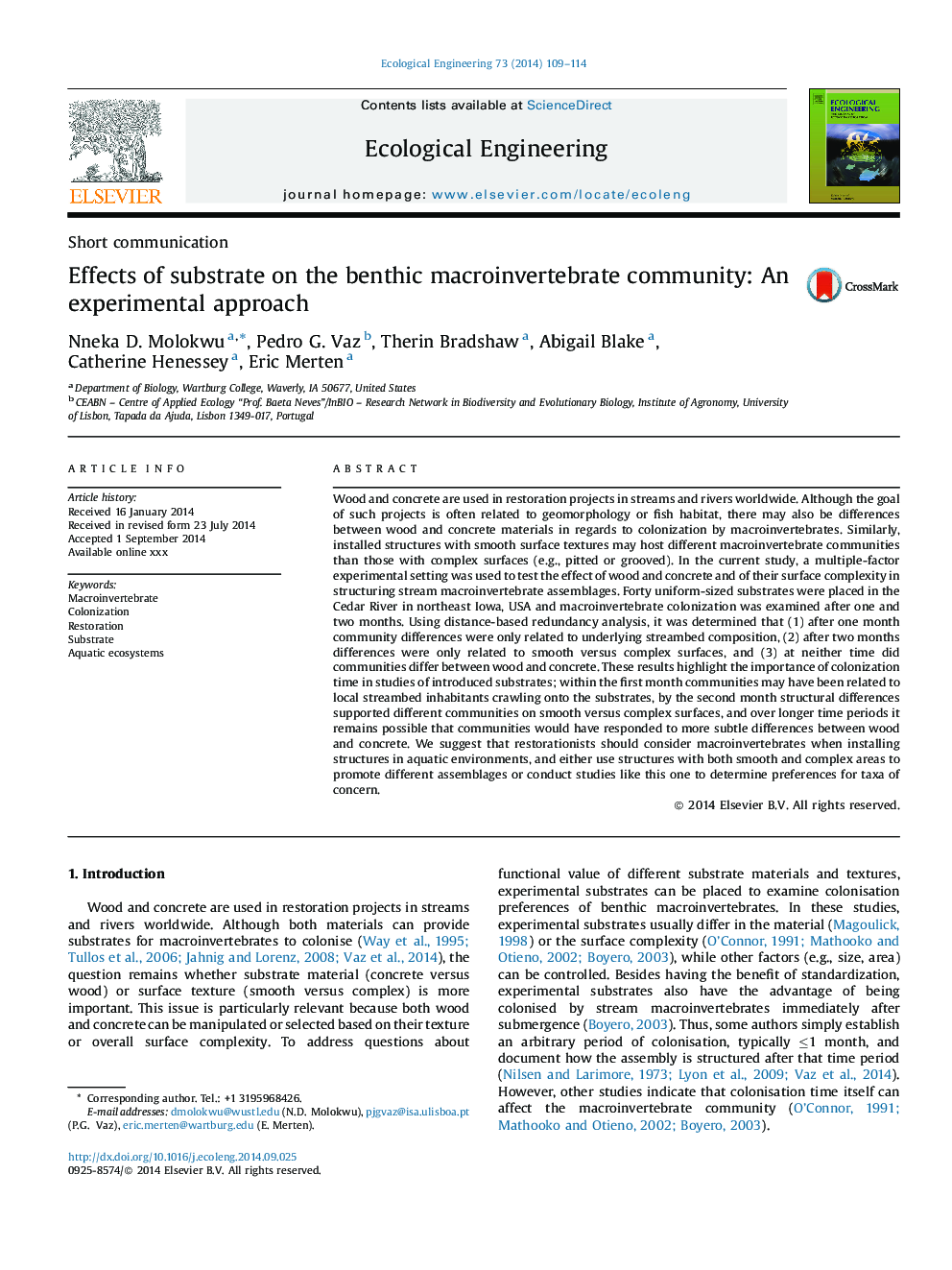| کد مقاله | کد نشریه | سال انتشار | مقاله انگلیسی | نسخه تمام متن |
|---|---|---|---|---|
| 6301859 | 1618026 | 2014 | 6 صفحه PDF | دانلود رایگان |
عنوان انگلیسی مقاله ISI
Effects of substrate on the benthic macroinvertebrate community: An experimental approach
ترجمه فارسی عنوان
اثرات سوبسترا در جامعه بتاتال مغز گردو: یک رویکرد تجربی
دانلود مقاله + سفارش ترجمه
دانلود مقاله ISI انگلیسی
رایگان برای ایرانیان
کلمات کلیدی
ترجمه چکیده
چوب و بتن در پروژه های بازسازی در جریان ها و رودخانه ها در سراسر جهان استفاده می شود. گرچه هدف از چنین پروژه هایی اغلب به ژئومورفولوژی یا زیستگاه ماهی مرتبط است، ممکن است تفاوت بین چوب و مواد بتنی در رابطه با استعمار توسط ماکروهشت مغولستان وجود داشته باشد. به طور مشابه، سازه های نصب شده با بافت های سطحی صاف، ممکن است جوامع مختلف مغناطیسی بدون توده را در مقایسه با سطوح پیچیده ای (مانند حفره یا حفره) داشته باشند. در مطالعه حاضر، برای آزمایش اثر چوب و بتن و پیچیدگی سطح آنها در ساختار جریان های توده های بزرگ ماست، از یک آزمایش چند فاکتور استفاده شد. چهل و نه برابر سطح زیرین در رودخانه سدر در شمال شرقی آیووا، ایالات متحده آمریکا قرار گرفت و پس از یک و دو ماه، کلونیزاسیون ماکرومونتربولاته بررسی شد. با استفاده از تجزیه و تحلیل بیش از حد مبتنی بر فاصله، مشخص شد که (1) پس از یک ماه تفاوت های اجتماعی تنها مربوط به ترکیب زیرسطحی جریان است، (2) پس از دو ماه تفاوت فقط مربوط به سطوح صاف در مقابل پیچیده و (3) در هیچ زمان جوامع بین چوب و بتن تفاوت دارند. این نتایج، اهمیت زمان استعمار را در مطالعات زیربنایی معرفی می کند؛ در جوامع اول ماه ممکن است با ساکنان ساحلی محلی که خزنده بر روی زیر شاخه ها هستند ارتباط داشته باشد، با تفاوت های ساختاری ماه دوم ماهیت جوامع مختلف را در سطوح صاف در مقابل پیچیده پشتیبانی می کند و در دوره های زمانی طولانی امکان پذیر است جوامع به تفاوت های ظریف تر پاسخ دهند بین چوب و بتن. ما پیشنهاد می کنیم که در هنگام نصب سازه ها در محیط های آبوهوایی، سازندگان مجتمع باید در هنگام مشاهده سازه ها در محیط های آبی توجه داشته باشند و یا از سازه هایی با زمینه های صاف و پیچیده برای ترویج مجموعه های مختلف استفاده کنند یا مطالعاتی مانند این را انجام دهند تا ترجیحات مربوط به تاکسی ها را مورد توجه قرار دهند.
موضوعات مرتبط
علوم زیستی و بیوفناوری
علوم کشاورزی و بیولوژیک
بوم شناسی، تکامل، رفتار و سامانه شناسی
چکیده انگلیسی
Wood and concrete are used in restoration projects in streams and rivers worldwide. Although the goal of such projects is often related to geomorphology or fish habitat, there may also be differences between wood and concrete materials in regards to colonization by macroinvertebrates. Similarly, installed structures with smooth surface textures may host different macroinvertebrate communities than those with complex surfaces (e.g., pitted or grooved). In the current study, a multiple-factor experimental setting was used to test the effect of wood and concrete and of their surface complexity in structuring stream macroinvertebrate assemblages. Forty uniform-sized substrates were placed in the Cedar River in northeast Iowa, USA and macroinvertebrate colonization was examined after one and two months. Using distance-based redundancy analysis, it was determined that (1) after one month community differences were only related to underlying streambed composition, (2) after two months differences were only related to smooth versus complex surfaces, and (3) at neither time did communities differ between wood and concrete. These results highlight the importance of colonization time in studies of introduced substrates; within the first month communities may have been related to local streambed inhabitants crawling onto the substrates, by the second month structural differences supported different communities on smooth versus complex surfaces, and over longer time periods it remains possible that communities would have responded to more subtle differences between wood and concrete. We suggest that restorationists should consider macroinvertebrates when installing structures in aquatic environments, and either use structures with both smooth and complex areas to promote different assemblages or conduct studies like this one to determine preferences for taxa of concern.
ناشر
Database: Elsevier - ScienceDirect (ساینس دایرکت)
Journal: Ecological Engineering - Volume 73, December 2014, Pages 109-114
Journal: Ecological Engineering - Volume 73, December 2014, Pages 109-114
نویسندگان
Nneka D. Molokwu, Pedro G. Vaz, Therin Bradshaw, Abigail Blake, Catherine Henessey, Eric Merten,
